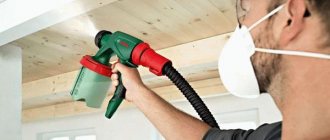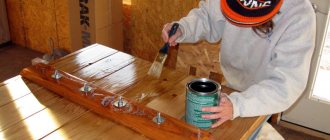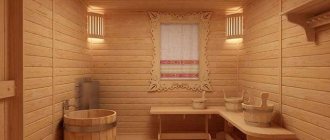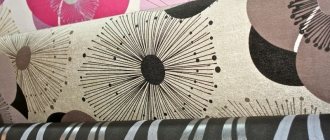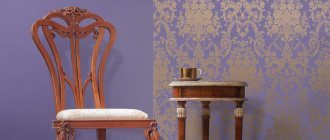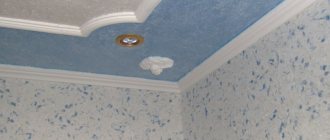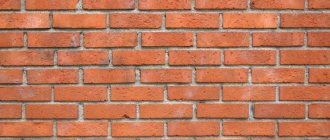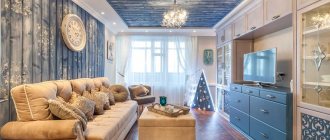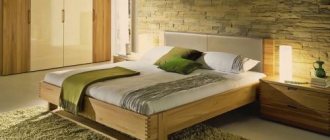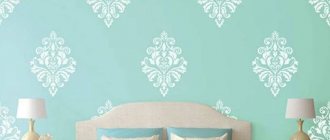Finishing the kitchen with clapboard is one of the economical ways to cover the walls of this room. It looks equally good in small apartments and spacious areas of private houses. Many people choose it, so manufacturers produce collections in different colors and from different materials, which allows you to choose it for any design.
Lining in the kitchen interior
from June 26, 2016
Lining is a thin board intended for finishing cladding of walls and ceilings. Suitable for both interior and exterior finishing work. Previously, lining was rarely found in home interiors, especially in urban ones. Usually it could only be seen on balconies, loggias, and verandas. Nowadays, lining is actively used even inside apartments, especially in kitchens.
What changed? Firstly, we have become more literate in matters of style. Some areas are characterized by plank cladding - in such interiors the lining is absolutely organic.
Secondly, there is a little more variety. There are several different profiles: standard, calm, euro, American, etc. The width of the boards also varies. Decorative cladding is also available - for example, with a wave or corrugated effect.
Thirdly, there are now good paints and colors that allow you to give the lining a more elegant look and, thanks to carefully selected colors, fit it into the interior as harmoniously as possible.
Design studio Laboratory 22
Lining is the name for covering not only wood, but also plastic and MDF. It is unlikely that anyone will argue with the fact that wood is most suitable for home interiors. It is environmentally friendly and durable. Wooden lining indoors will last at least 15-20 years.
Cladding in classic interior styles
Experienced designers introduce this material into different interior styles, among them the most common is classic. To do this, you only need to choose the design of the lamellas. Most would choose wood of high quality and processing, with a matte finish that complements all the elements from the classic direction. These are gilded elements, soft seating and warm colors - creating a special harmony inside the room, without unnecessary details.
A wide selection of high-quality paint allows you to give the material the necessary shade to optimally fit it into the interior.
Lining in the kitchen: for which styles?
First of all, wooden cladding of walls and ceilings is relevant for country or cottage (“dacha”) style. Here the lining can be left unpainted. If we are talking about the Provence style, which is distinguished by its special softness and grace, it is better to paint the board.
Country style kitchen in an apartment. Design: Perm studio Laboratory 22
Kitchen in the country. Design: More Decor bureau for the “Dachny Otvet” program
The use of lining is widespread in Scandinavia. Most often, it is used to cover the walls inside private houses, but the board can also be found in the interiors of city apartments. Both walls and ceilings are covered with lining. In most cases, the board is painted white. Scandinavian style is now very popular in the world, including here. Hence the increased interest in lining as a material for interior decoration.
White lining in a Scandinavian kitchen
The lining is also harmonious in the so-called eco-design. If you need to bring natural motifs into the interior, you can’t do without wood.
Wood paneling is appropriate even in modern classics. But here it is used mainly in the form of panels and always in painted form.
Kitchen set made of lining
The material can be used not only for finishing walls and ceilings, but also for kitchen furniture. Decorating a kitchen apron from clapboard is an original option for creating a comfortable and cozy kitchen. The material can also be used for lining cabinets and bedside tables.
Wooden set
When choosing lining for kitchen fittings, you need to ensure that it matches the texture and color of the wall covering. If they are plastered, then you can choose the option that best suits the style of the kitchen. The material can be used to decorate the backdrop. It is mounted in the locations of the cabinets.
Kitchen lining is an original way to decorate a room. Thanks to its versatility, you can decorate your kitchen in any style. The material has a simple design, which allows you to install it yourself.
The use of lining in the kitchen interior
You can cover all the walls of the room with it or highlight only the dining area. The last option is the most common.
Painted paneling in a cottage-style kitchen
Design: interior design studio DREAM SPACE
They also use lining in work areas, that is, on the “apron”. If the board is treated with an antiseptic and coated with moisture-resistant kitchen paint, maintaining the surface of the apron is not a problem.
But for reliability, you can cover part of the wall above the stove with tiles or cover the entire working wall with transparent tempered glass. This will protect the casing from negative influences.
The working wall is covered with transparent glass
The lining, located only at the bottom of the wall, looks completely different. The surface above the sheathing is painted or covered with wallpaper. The border between them is formed by a wide strip (molding). It turns out to be a kind of imitation of classic wall panels a la Wainscot. This finishing option is appropriate in interiors of such styles as American and French classics, Provence, and English country.
Photo from deccoria.pl
Another way to use lining in the kitchen is to create a so-called backdrop for cabinets and cabinets. Only that part of the room where the kitchen unit is installed is covered with boards.
Country style kitchen. Design:
Kitchen in Provence style. Design: Evgenia Shimkevich
Many people have a question: how to place the lining on the wall - horizontally or vertically? It is usually positioned vertically. But if there is a need to visually expand the kitchen space, you can make horizontal cladding. This is acceptable. There are no canons on this matter.
Design: Atelier Interior
By the way, if you like the look of a covered wall, but don’t have the desire or ability to install lining, it’s worth looking for wallpaper with its imitation. Modern wallpaper imitates almost any finish, and lining is no exception. True, wallpaper that imitates it is almost always white, without the texture and pattern of wood. But they can be painted any color you like.
Advantages of using lining
Each type of material has certain specifics. You can see the features in the photo of the kitchen lining. But their plank structure is similar, which provides several obvious advantages. Application of these materials:
- allows you to mask small defects on surfaces;
- ensures simplicity and efficiency of installation;
- guarantees an impeccable appearance to walls and ceilings.
Lining allows you to mask defects on surfaces
The material can be mounted on any surface. If they have small cracks or gouges, no preliminary preparation is required. The slats will reliably hide these defects. Locking connections allow you to quickly and easily install the material. The planks fit tightly to each other, eliminating the possibility of moisture penetrating the walls, which prolongs their service life. In the photo of kitchens covered with clapboard, you can evaluate the uniformity of the coatings.
The slats fit tightly to each other
Numerous photos of the lining in the kitchen allow you to see the attractiveness of this finish. A wide range of types and shades makes it possible to choose the best option for any interior.
The lamellas differ in thickness, width, and now there are original textured materials on the market. The planks can be mounted vertically, horizontally, and can be used to successfully visually correct the room. Photos of lining designs in the kitchen will help you choose the right finishing option.
Bright accents
Natural solid wood panels can be used to completely decorate a room (from ceiling to floor). To avoid “Soviet era” design, it is recommended to make a bright accent. This could be the kitchen set itself, part of it (for example, a countertop) or even a dining group. You can also highlight one of the walls by painting it in an intense color. Warm colors are best: orange, brown, green, cream. And, of course, you will need to buy high-quality lining for covering the kitchen.
A set in a modern style with bright decorative accents.
Set in Scandinavian style. The accent is a countertop imitating marble.
A set in a modern style for a country house.
Set in the color of the lining
It is worth paying attention to the choice of facades. Opt for smooth or slightly milled ones. If possible, discard the upper sections or replace them with niches or shelves. This will make your kitchen laconic and airy. It is better to choose appliances and accessories (sink, faucet, rails, lamps and handles) in the same color scheme.
A laconic set to match the design. Modern style.
Country style set.
The kitchen is decorated in one tone.
Eclecticism
The combination of different styles and materials in decoration is called eclecticism. It is recommended to decorate one or two walls with clapboard, and choose the direction of the wood texture horizontally.
A set in a modern style in an eclectic room design.
A set in a classic style in an eclectic room design.
Combination of finishing materials in finishing. Minimalism.
Provence
One of the popular design styles is “Provence”, also called “French country”. Use wood that is very light or painted white, vanilla or pistachio as an alternative to bowsery (a decorative wall made from solid wood). Also for decorating ceilings and floors. Your kitchen will acquire a unique European charm.
Kitchen in Provence style. Wall and ceiling decor.
Scandinavian style
Distinguishing features are natural materials and light, sometimes even cold, tones. Following the example of “Provence,” painting the lining can replace a decorative apron made of boiserie.
Kitchen in Scandinavian style. Wall decor. Imitation bowsery.
If you have chosen this finishing material, you have a large selection of design solutions open to you. Ease of installation will save effort and time. Lining is an environmentally friendly natural material. At the same time, a very budget option available to everyone.
Clapboard finishing in modern styles
Modern residents of megacities and small towns often want to make their home unique and inimitable. In such situations, experimental ways to diversify standard style trends are what save the day. If you try to combine lining and loft, then, at first glance, it seems impossible. But if you figure out what color of kitchen unit to go with the lining, then everything will fall into place. Usually the solution is a general matte style and a single color.
If the lining is made of natural wood, then its aroma gives a unique atmosphere to the room.
High-tech involves more glossy surfaces, so it is preferable to make lamellas in this format. They can organically decorate one of the walls or become an apron.
Wood material of the highest category has a high cost.
And in minimalism, you can play with the material in an interesting way if you make it an inspiring part of the room. White wood or high-quality white plastic without toxic fumes is suitable for this. This direction does not accept colors other than basic white, so owners will have to find the right shade and slats to create a single harmonious picture.
The kitchen, decorated with wooden paneling, is filled with a special atmosphere and indescribable comfort.
By the way: if you have doubts about the chosen material or its appropriateness, it is better to show the project to an interior designer and ask for his professional opinion.
Finishing the kitchen with clapboard (39 photos) - a master of his own
One of the simplest and most economical ways to decorate walls in the kitchen is to cover them with clapboard. This is especially true in new brick buildings and cottages, when for other finishing the walls need to be plastered. The lining will look great in the interior of the kitchen; it will create a warm and cozy atmosphere in it.
It is important that for high-quality plastering, putty and further painting you will have to invite specialists, but it is quite possible to cover a kitchen with clapboard yourself.
The kitchen walls are lined with larch clapboard.
Today we will try to figure out how this can be done.
Types of lining
The evolution of the development of woodworking and design ideas has given 6 types of carriage boards according to its profile (sectional shape).
Standard profile . The cross section of this board has the shape of a trapezoid. The front part of the board is planed with stiffening ribs. At the ends of the board there is a tongue-and-groove connection.
Calm profile . A characteristic feature of this board is the visually noticeable rounded edges of the board.
Euro-profile (soft-line). This type of finishing board has enlarged tongue-and-groove joints.
Eurolining . The board is almost similar to the Euro-profile, but with improved humidity, geometry and processing.
American type lining . The cross section of this board is beveled in one direction. Because of this, an overlapping pattern of boards is created on the wall.
Finishing a kitchen with clapboard involves using any type of clapboard. It all depends on the location of the kitchen and the quality of the required finishing of the room. Eurolining has a theoretical advantage in quality. In fact, everything depends on the manufacturer and the quality of the lining is determined not by its profile, but by the production conditions. When selling, the quality of the lining is marked by its grade.
Related article: Gas boiler does not work, what to do
Types of lining
Before choosing a certain type of lining, you need to understand what they are and what the differences are (also find out how to decorate the walls in the kitchen).
PVC (plastic)
Colored plastic lining.
PVC (plastic) lining is intended for finishing walls and ceilings; it is produced without patterns, but can be of different colors.
It is this modern material that allows you to get tangible savings when finishing walls and ceilings. PVC lining, the price of which is significantly low and pleases potential buyers, is perfect for installation in any room, including the kitchen.
Wooden
Wooden lining is divided into classes:
- Extra, completely free of knots and defects;
- A – only light live knots are possible, no more than one per 1.5 meters in length;
- B – knots can be dark, no more than four per 1.5 meters in length;
- C – knots may fall out.
Naturally, the higher the class, the better the quality of the material.
Important. To cover walls in the kitchen, as in other rooms, use only well-dried boards; its humidity should not exceed 15%. The ideal option is material treated with an antifungal compound and dried in an autoclave.
Plastic lining for finishing the kitchen
Plastic lining in the kitchen is in great demand among buyers. Plastic is waterproof, durable, easy to maintain and lightweight. With the help of modern technologies, unique coatings are applied to the surface of plastic products. They allow you to imitate the pattern of valuable wood species.
The wealth of colors used allows the use of various interior solutions. Ease of installation, ease of maintenance and low cost make plastic lining the most popular material for finishing kitchens.
The following types of products are used to decorate the kitchen:
- Plastic lining;
- Plastic panels;
- PVC sheet.
The plastic lining has a width of 10 to 15 cm. The standard length is from 1 to 3 m. The thickness of the lining varies from 3 to 10 mm. The surface is factory painted. Plastic panels have a width from 15 to 50 cm. The length of the panels varies from 1.5 to 3.0 m. The thickness of the panel ranges from 5 to 15 mm. Plastic sheets are available in widths from 0.8 to 2.0 m. Sheet length varies from 1.5 to 4.0 meters. The thickness of the product ranges from 1 to 30 mm. Plastic products are the best option for finishing kitchens in city apartments. Plastic is used in large quantities to decorate the kitchens of cafes, restaurants and bars.
PVC products have the following advantages:
- Easy installation;
- Variety of shapes and colors;
- Easy care;
- A light weight;
- Low cost.
The following methods are used to install plastic products in the kitchen:
- Bonding with adhesives;
- Screwing with fasteners;
- Installation on wooden lathing;
- Installation on metal profiles.
Gluing plastic using adhesive mixtures is the easiest installation method. Plastic elements are glued to a clean, flat surface. To do this, the walls are first leveled by applying a layer of plaster. Before applying the plaster, the walls and ceiling are treated with a primer.
For your information. To ensure a uniform and durable layer, gypsum-based plaster is used. This material is easy to use, durable and quick to set.
Lining in the kitchen: choice, pros and cons
join the discussion
Share with your friends
Lining is one of the most popular finishing materials. The high demand for it is explained simply - it is environmentally friendly, easy to install and at the same time has an affordable price. How can you use lining in the kitchen interior?
Painting the lining inside the house in different colors: beautiful ideas in the interior
By varying different colors, you can significantly expand the choice of style, create bright accents indoors and at the same time make the wood more resistant to adverse influences.
Lining for the ceiling Source domostroy-khv.ru
The lining in the interior does not always suit the style of a particular room; painting it in different colors makes it more suitable for the interior. The material must be painted before it is installed on the wall or ceiling.
Using clear varnish makes the wood texture more pronounced. You can slightly zone the surface.
Lining on the balcony Source domodedovo.mebelsam.net
The clapboard ceiling in a country or Provence style room should be painted white and the beams made dark.
Beams on the ceiling in the kitchen Source steaten.com
White color is universal for any design. It fits easily into the room; the combination of light matte and varnished lining on the walls and ceilings is especially beautiful. This gives a feeling of open space and spaciousness. White matte board is a necessary element of the Scandinavian style.
Kitchen interior Source legko.com
The warm varnished surface emphasizes the warmth and comfort of the Provence style.
Interior of a house with clapboard Source Interior of a house with clapboard
The use of oil paints creates an unusual texture on the surface of the wood. Some designers generally advise applying paint with your hands rather than with a brush.
Matte varnish for lining Source optolov.ru
Advantages and disadvantages
Not every owner decides to decorate the kitchen space with clapboard. The fact is that for the majority this material is firmly associated with the “masterpieces” of Soviet decoration or even with a bathhouse. However, interior designers claim that with the proper use of material, any room can be made truly cozy and conceptual, and it is quite possible to decorate it in both a classic and ultra-modern style.
Lining is the optimal solution for interiors decorated in eco-style, as well as in such directions as country, Provence and shabby chic. When properly combined with other materials, lining can be used in loft interiors. Nowadays, the material is produced in a wide variety of different textures and shades, so the lining can be given the most sophisticated look and fit harmoniously into any interior.
Installation technique for this cladding
One of the advantages that unites all types of lining for kitchen finishing is the ability to install it yourself. This is due to the presence of a tongue-and-groove type fastening, due to which all segments of the cladding are firmly and reliably fastened together. Before you begin the process itself, you can look at the stages of work in the photographs of finishing the kitchen walls with clapboard and make sure that they are not particularly difficult.
Example of panel installation
The installation can be completed quite quickly, because this particular facing material does not require preparatory work on the surface (it does not need to be brought to perfect evenness and smoothness), because the panels are not attached to it, but to a specially equipped sheathing.
The lathing for finishing kitchen walls with clapboard is made from wooden or metal slats, prepared and cut in advance. First, the first rail is placed along the lower level of the cladding, then the last one is placed on top. Next, at a distance of 30-50 cm from each other, the remaining horizontal planks are attached to the wall surface, and then the first corner profile is installed (most often the left corner is chosen to start). The first panel is inserted into the groove of this profile, and then the second, third, and so on (until the next corner profile, and from it along the wall). Fastening to the frame is done with self-tapping screws, then ceiling and floor plinths are installed on top and bottom.
The kitchen is the most favorite place in the family. People spend most of their time here. A beautiful and warm room gives a feeling of comfort and coziness. Therefore, the closest attention is paid to the renovation and decoration of the kitchen. Lining in the kitchen gives the room sophistication and special style.
Selection of lining
The lining can be made of plastic or wood. Obviously, wood is most suitable for furnishing home interiors, since it is an environmentally friendly, practical and durable material. Indoor cladding will serve its owners for at least 15-20 years without deteriorating its original appearance. Depending on the quality of the material, wooden lining is divided into several classes:
- extra - panels that are completely free of any defects (cracks and knots);
- A - the presence of live light knots is allowed, but their number does not exceed 1 per 1.5 m of length;
- B - the presence of dark live knots is possible in an amount of up to 4 units per every 1.5 meters;
- C - in this case the knots may be falling out.
Styles
Lining can be used for kitchen design in a variety of styles. Wooden wall cladding is harmonious in country (cottage) style, as well as in country interiors - in this case the surface is left in its natural form, unpainted. If you prefer Provence, which is more refined and soft, then it is better to paint the board. For lovers of vintage style and shabby chic, it makes sense to additionally age the surface - then it will be 100% in style.
The lining effectively complements the Scandinavian style, this is not surprising, because in Finland, Norway and Sweden, wooden panels are used more often than other materials to decorate walls inside private houses and city apartments. As a rule, boards are tinted white.
The Scandinavian style is now one of the most popular all over the world, and our country is no exception - this is where a new surge of interest in lining as a finishing material for the kitchen arose.
Of course, you can’t do without lining in so-called eco-houses , as well as in areas that require natural motifs in the interior. Wooden cladding can also be used in modern classics , although in this case its use is limited. Only panels are used here and always in pre-painted form.
Lining in a kitchen interior in a private house
Private sectors often include houses that are ideally suited to Scandinavian, Provence or country style; these are the most profitable themes for using clapboard cladding. She looks harmonious, stylish and appropriate in them, which cannot be said about many modern trends, such as hi-tech or loft, they must be combined carefully. This method is the optimal variation for introducing the material not only outside, but also as a kitchen design.
Its popularity is also explained by the environmental friendliness of the material and the ability to give an aesthetic appearance.
